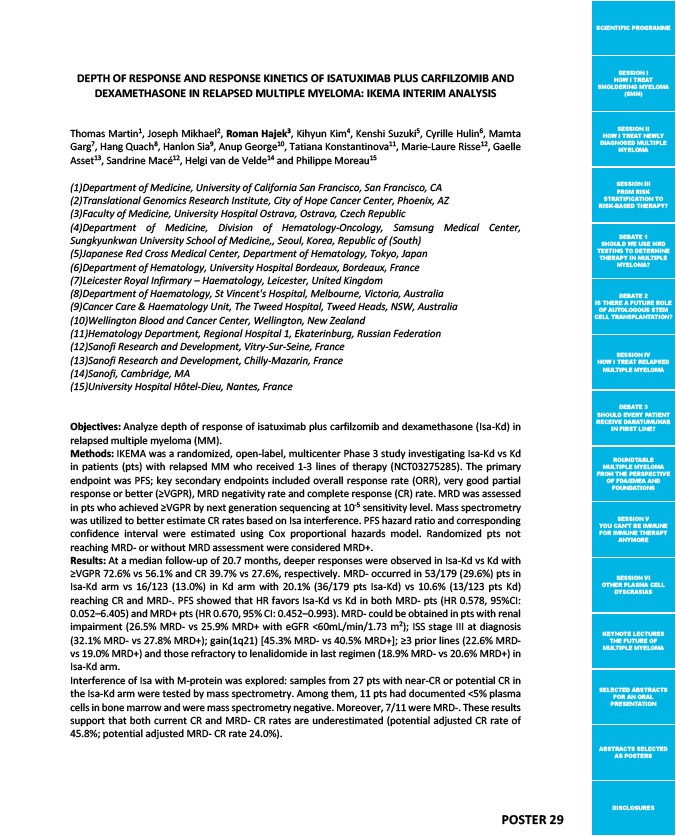
SCIENTIFIC PROGRAMME
SESSION I
HOW I TREAT
SMOLDERING MYELOMA
(SMM)
SESSION II
HOW I TREAT NEWLY
DIAGNOSED MULTIPLE
MYELOMA
SESSION III
FROM RISK
STRATIFICATION TO
RISK-BASED THERAPY?
DEBATE 1
SHOULD WE USE MRD
TESTING TO DETERMINE
THERAPY IN MULTIPLE
MYELOMA?
DEBATE 2
IS THERE A FUTURE ROLE
OF AUTOLOGOUS STEM
CELL TRANSPLANTATION?
SESSION IV
HOW I TREAT RELAPSED
MULTIPLE MYELOMA
DEBATE 3
SHOULD EVERY PATIENT
RECEIVE DARATUMUMAB
IN FIRST LINE?
ROUNDTABLE
MULTIPLE MYELOMA
FROM THE PERSPECTIVE
OF FDA/EMEA AND
FOUNDATIONS
SESSION V
YOU CAN’T BE IMMUNE
FOR IMMUNE THERAPY
ANYMORE
SESSION VI
OTHER PLASMA CELL
DYSCRASIAS
KEYNOTE LECTURES
THE FUTURE OF
MULTIPLE MYELOMA
SELECTED ABSTRACTS
FOR AN ORAL
PRESENTATION
ABSTRACTS SELECTED
AS POSTERS
DISCLOSURES
DEPTH OF RESPONSE AND RESPONSE KINETICS OF ISATUXIMAB PLUS CARFILZOMIB AND
POSTER 29
DEXAMETHASONE IN RELAPSED MULTIPLE MYELOMA: IKEMA INTERIM ANALYSIS
Thomas Martin1, Joseph Mikhael2, Roman Hajek3, Kihyun Kim4, Kenshi Suzuki5, Cyrille Hulin6, Mamta
Garg7, Hang Quach8, Hanlon Sia9, Anup George10, Tatiana Konstantinova11, Marie-Laure Risse12, Gaelle
Asset13, Sandrine Macé12, Helgi van de Velde14 and Philippe Moreau15
(1)Department of Medicine, University of California San Francisco, San Francisco, CA
(2)Translational Genomics Research Institute, City of Hope Cancer Center, Phoenix, AZ
(3)Faculty of Medicine, University Hospital Ostrava, Ostrava, Czech Republic
(4)Department of Medicine, Division of Hematology-Oncology, Samsung Medical Center,
Sungkyunkwan University School of Medicine,, Seoul, Korea, Republic of (South)
(5)Japanese Red Cross Medical Center, Department of Hematology, Tokyo, Japan
(6)Department of Hematology, University Hospital Bordeaux, Bordeaux, France
(7)Leicester Royal Infirmary – Haematology, Leicester, United Kingdom
(8)Department of Haematology, St Vincent's Hospital, Melbourne, Victoria, Australia
(9)Cancer Care & Haematology Unit, The Tweed Hospital, Tweed Heads, NSW, Australia
(10)Wellington Blood and Cancer Center, Wellington, New Zealand
(11)Hematology Department, Regional Hospital 1, Ekaterinburg, Russian Federation
(12)Sanofi Research and Development, Vitry-Sur-Seine, France
(13)Sanofi Research and Development, Chilly-Mazarin, France
(14)Sanofi, Cambridge, MA
(15)University Hospital Hôtel-Dieu, Nantes, France
Objectives: Analyze depth of response of isatuximab plus carfilzomib and dexamethasone (Isa-Kd) in
relapsed multiple myeloma (MM).
Methods: IKEMA was a randomized, open-label, multicenter Phase 3 study investigating Isa-Kd vs Kd
in patients (pts) with relapsed MM who received 1-3 lines of therapy (NCT03275285). The primary
endpoint was PFS; key secondary endpoints included overall response rate (ORR), very good partial
response or better (≥VGPR), MRD negativity rate and complete response (CR) rate. MRD was assessed
in pts who achieved ≥VGPR by next generation sequencing at 10-5 sensitivity level. Mass spectrometry
was utilized to better estimate CR rates based on Isa interference. PFS hazard ratio and corresponding
confidence interval were estimated using Cox proportional hazards model. Randomized pts not
reaching MRD- or without MRD assessment were considered MRD+.
Results: At a median follow-up of 20.7 months, deeper responses were observed in Isa-Kd vs Kd with
≥VGPR 72.6% vs 56.1% and CR 39.7% vs 27.6%, respectively. MRD- occurred in 53/179 (29.6%) pts in
Isa-Kd arm vs 16/123 (13.0%) in Kd arm with 20.1% (36/179 pts Isa-Kd) vs 10.6% (13/123 pts Kd)
reaching CR and MRD-. PFS showed that HR favors Isa-Kd vs Kd in both MRD- pts (HR 0.578, 95%CI:
0.052–6.405) and MRD+ pts (HR 0.670, 95% CI: 0.452–0.993). MRD- could be obtained in pts with renal
impairment (26.5% MRD- vs 25.9% MRD+ with eGFR <60mL/min/1.73 m2); ISS stage III at diagnosis
(32.1% MRD- vs 27.8% MRD+); gain(1q21) 45.3% MRD- vs 40.5% MRD+; ≥3 prior lines (22.6% MRD-
vs 19.0% MRD+) and those refractory to lenalidomide in last regimen (18.9% MRD- vs 20.6% MRD+) in
Isa-Kd arm.
Interference of Isa with M-protein was explored: samples from 27 pts with near-CR or potential CR in
the Isa-Kd arm were tested by mass spectrometry. Among them, 11 pts had documented <5% plasma
cells in bone marrow and were mass spectrometry negative. Moreover, 7/11 were MRD-. These results
support that both current CR and MRD- CR rates are underestimated (potential adjusted CR rate of
45.8%; potential adjusted MRD- CR rate 24.0%).